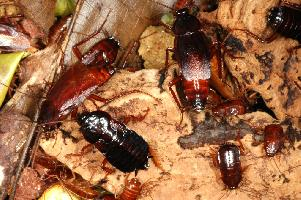
Váhy a míry
| Délka | od 21 do 28 mm |
|---|
Popis zvířete
The Oriental cockroach (Blatta orientalis), often referred to as the waterbug or black beetle, is a large species of cockroach native to the warm, temperate and tropical regions of Africa. However, it has spread widely around the world and is commonly found in human habitats, especially in urban areas. This species has adapted to live in close association with humans and can often be found in homes, apartment buildings, restaurants, and any other places where food and moisture are readily available.The Oriental cockroach has a glossy, dark brown or almost black exoskeleton, which contributes to its common name, the black beetle. Unlike some other cockroach species, Oriental cockroaches have a somewhat different appearance between males and females. Adult males are about 18 to 29 mm in length and have wings that cover about three-quarters of their abdomen, though they are incapable of flight. The females, on the other hand, are slightly larger, about 20 to 27 mm in length, with very short, non-functional wings and a wider body shape. This dimorphism makes it relatively easy to distinguish between the sexes.
One of the most notable characteristics of the Oriental cockroach is its preference for cooler, damp environments. They are often found in basements, crawl spaces, and around drains, pipes, or any areas with high moisture levels. Unlike some other species that might invade the upper floors of buildings, Oriental cockroaches are more commonly found on or below ground level. They are nocturnal creatures, emerging from their hiding spots at night to search for food and water. Their diet is omnivorous but decomposing organic matter is particularly attractive to them, which is why they are often found in unsanitary conditions and can be vectors for various pathogens.
The life cycle of the Oriental cockroach involves three stages: egg, nymph, and adult. The female produces egg cases (oothecae), which she carries for about a day before depositing it in a protected area. Each egg case contains around 16 eggs, and the nymphs emerge after about two months. The nymphs are initially pale white but darken to a reddish-brown before finally becoming the dark color of the adults. Depending on environmental conditions, it can take anywhere from 6 to 18 months for nymphs to mature into adults. The entire lifecycle and the rate at which populations grow can be significantly influenced by temperature and humidity.
Oriental cockroaches can pose several health risks to humans. They are known to carry pathogens on their bodies and in their feces that can cause diseases such as gastroenteritis, diarrhea, and other food poisoning symptoms. They can also trigger allergic reactions and asthma in susceptible individuals due to the allergens found in their droppings, shed skins, and saliva.
Control and management of Oriental cockroach infestations involve a combination of sanitation measures, exclusion techniques to prevent entry, and the use of insecticides when necessary. Reducing moisture through improved ventilation, repairing leaky pipes, and eliminating food sources by keeping areas clean and storing food in sealed containers can help deter these pests. Sealing cracks and crevices in walls, floors, and around pipes can prevent their entry from outside or other infested areas.
In conclusion, the Oriental cockroach is a resilient and adaptable pest that can cause various health issues and is often a sign of poor sanitary conditions. Effective management requires a comprehensive approach that combines good hygiene practices with targeted pest control measures.
Nové fotografie zvířat
Top 10 zvířat
- Chinese water dragon (Physignathus cocincinus)
- Galápagos tortoise (Geochelone nigra complex)
- Dolphin gull (Leucophaeus scoresbii)
- Japanese macaque (Macaca fuscata)
- Colombian red howler (Alouatta seniculus)
- Sea urchins (Echinoidea)
- Moustached guenon (Cercopithecus cephus)
- Diana monkey (Cercopithecus diana)
- Common reed warbler (Acrocephalus scirpaceus)
- Common house mosquito (Culex pipiens)